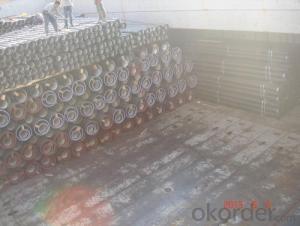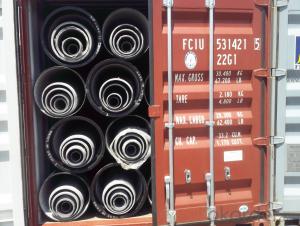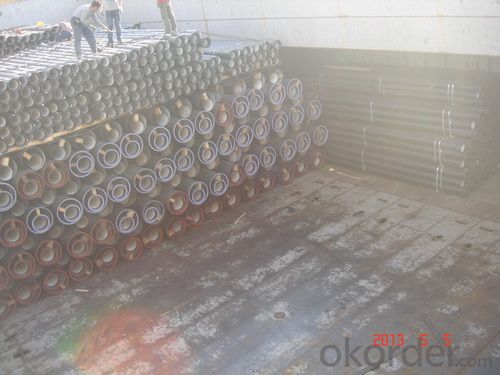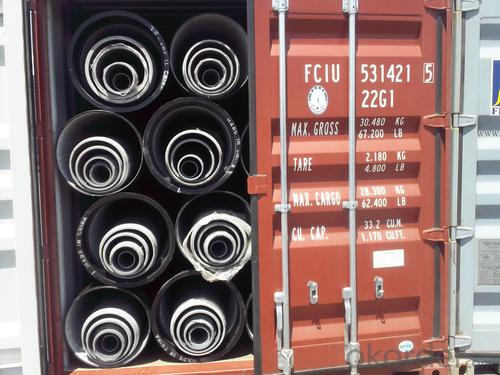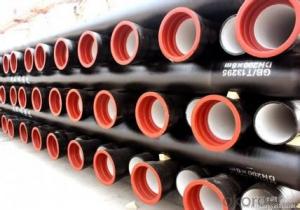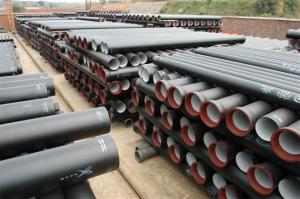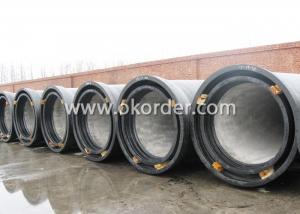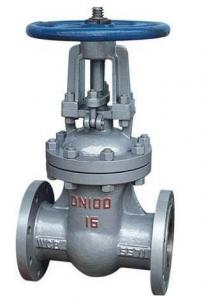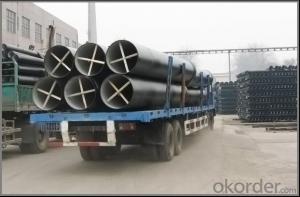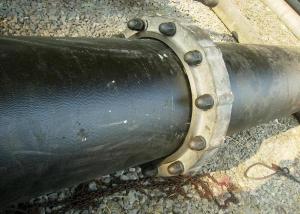DUCTILE IRON PIPE D150
- Loading Port:
- Tianjin
- Payment Terms:
- TT OR LC
- Min Order Qty:
- -
- Supply Capability:
- 30000Tons m/month
OKorder Service Pledge
OKorder Financial Service
You Might Also Like
CNBM ductile iron pipe ranges from DN80-DN1600mm (T-Type, Class K9), effective length 6m, comply with ISO2531 Standard
Company Profile
CNBM International Corporation is the leading production base and renowned supplier of Ductile Iron Water Pipe systems of both potable and waste water in China. We are constantly looking to develop high quality products to ensure the longest service life and wonderful performance.
CNBM Pipelines regard quality as the essential factor leading to successful business. Every pipe is tested in accordance with BS EN545 (water application) or BS EN598 (sewer application). CNBM Pipelines products comply with and are tested according to the relevant European and International Standards. Our pipes are manufactured under the quality management system BS EN ISO 9001. After years of efforts, CNBM Pipelines has built up great reputation in terms of quality and service among customers worldwide
Product Introduction
CNBM ductile iron pipe ranges from DN80-DN1600mm (Tyton, T-Type, Class K7/K8/K9), effective length: 6m, complying with BS EN545/EN598/ISO2531/BS4772.
Specification& Payment terms
Internal lining: Pipes shall have an internal cement mortar lining in acc with ISO4179.
External coating: Pipes shall be externally coated with metallic zinc spray plus a further layer of resin painting to ISO8179.
Gasket: 100% SBR/NBR/EPDM gasket in accordance with ISO4633.
Packing: Pipes from DN100 to DN300 be bundled with steel belts, the others are in bulk.
Payment term: By 30% T/T advance payment + 70% Irrevocable L/C at sight.
Packing: In bulk vessel or in container.
- Q: Are ductile iron pipes suitable for landfill leachate collection?
- Yes, ductile iron pipes are suitable for landfill leachate collection. Ductile iron pipes have excellent strength and durability, making them capable of withstanding the harsh and corrosive nature of landfill leachate. Additionally, they have a long lifespan and are resistant to both external and internal corrosion, making them a reliable choice for this application.
- Q: Are ductile iron pipes suitable for high-temperature applications?
- Ductile iron pipes are generally not suitable for high-temperature applications. While ductile iron is known for its strength and durability, it has limitations when it comes to high temperatures. Ductile iron pipes are typically rated for a maximum operating temperature of around 250-300 degrees Fahrenheit (120-150 degrees Celsius). At higher temperatures, ductile iron pipes can experience thermal expansion, which may lead to cracking or distortion. This can compromise the structural integrity of the pipe and potentially cause leaks or failures. Additionally, ductile iron is susceptible to oxidation at elevated temperatures, which can further degrade the pipe's performance over time. For high-temperature applications, it is generally recommended to use materials specifically designed for such conditions, such as stainless steel or high-temperature alloys. These materials offer better resistance to thermal expansion, oxidation, and other factors associated with high temperatures.
- Q: What are the different types of ductile iron pipe joints?
- Various applications commonly utilize different types of ductile iron pipe joints to ensure efficient fluid transfer and prevent leaks. These joints provide strong and reliable connections between pipes. Some of the most frequently used types of ductile iron pipe joints are as follows: 1. Push-on Joint: This joint is simple to install and does not require any special tools. The spigot end of one pipe is inserted into the bell end of another pipe, creating a tight seal. A rubber gasket is typically used to enhance leak resistance. 2. Mechanical Joint: Water and wastewater applications often use mechanical joints. They consist of a gland, a rubber gasket, and a follower gland. The pipe ends are pushed into the gland, and the follower gland is tightened, compressing the rubber gasket and establishing a secure connection. 3. Restrained Joint: These joints are designed to withstand high internal and external forces, such as water pressure or soil loadings. Rubber gaskets and restraining mechanisms like bolts or wedges are commonly used to prevent pipe movement or separation under stress. 4. Flanged Joint: Large diameter pipes or applications requiring frequent disassembly often employ flanged joints. Each pipe end is equipped with a flange, which is then bolted together with gaskets to create a strong connection. Flanged joints provide convenient access for maintenance or repairs. 5. Welded Joint: Welded joints involve heating and fusing the pipe ends to form a permanent connection. This type of joint is typically used in high-pressure applications where a reliable and leak-free connection is crucial. Skilled labor and specialized equipment are required for welded joints. To ensure the integrity and longevity of the ductile iron pipe system, it is important to choose the appropriate joint based on the specific application, pipe size, and operating conditions. Consulting with a professional engineer or pipe manufacturer can help determine the most suitable joint for a particular project.
- Q: What is the expected fire resistance of ductile iron pipes?
- The expected fire resistance of ductile iron pipes is high due to their ability to withstand high temperatures without losing structural integrity. They have a melting point of approximately 1200°C, making them suitable for applications where fire protection is crucial.
- Q: What are the environmental benefits of using ductile iron pipe?
- There are several environmental benefits associated with using ductile iron pipe in various applications. Firstly, ductile iron is a highly durable material that can withstand harsh environmental conditions and has a long lifespan. This means that ductile iron pipes require less frequent replacements compared to other pipe materials, reducing the need for resource-intensive manufacturing processes and minimizing the disposal of old pipes. Secondly, ductile iron pipes have excellent corrosion resistance properties, which reduces the risk of leaks and pipe failures. This not only prevents potential water contamination but also minimizes the wastage of water resources. Additionally, ductile iron is a recyclable material. At the end of its useful life, ductile iron pipes can be melted down and used to manufacture new products, reducing the demand for virgin materials and conserving natural resources. Furthermore, the manufacturing process of ductile iron pipe has improved significantly over the years, resulting in reduced energy consumption and emissions. Today, many manufacturers use energy-efficient technologies and practices to produce ductile iron pipes, contributing to a lower carbon footprint and reduced air pollution. Lastly, ductile iron pipes have a smooth internal surface that minimizes friction and allows for efficient water flow. This can lead to energy savings in pumping and distribution systems, as less energy is required to transport water through the pipeline network. Overall, using ductile iron pipe can have a positive impact on the environment by reducing waste, conserving resources, minimizing pollution, and improving energy efficiency in water distribution systems.
- Q: Are ductile iron pipes suitable for use in mining tailings pipelines?
- Yes, ductile iron pipes are suitable for use in mining tailings pipelines. Ductile iron has excellent strength and durability properties, making it capable of withstanding the high pressure and abrasive nature of tailings. Furthermore, its corrosion resistance and ability to withstand harsh environmental conditions make it a reliable choice for mining applications.
- Q: Are ductile iron pipes suitable for pressure sewer systems?
- Ductile iron pipes, known for their high strength and durability, are a suitable option for pressure sewer systems. They have been widely used in various applications, including pressure sewer systems, due to their ability to withstand high pressure and provide a long-lasting solution for transporting sewage under pressure. One key advantage of ductile iron pipes is their excellent corrosion resistance, which is crucial in sewer systems where they are exposed to various chemicals and contaminants. These pipes are resistant to both internal and external corrosion, ensuring their durability and functionality over time. Moreover, ductile iron pipes have a smooth internal surface, minimizing friction and improving the flow capacity of the sewer system. This feature allows the pipes to handle the required flow rates and prevent blockages or backups. Additionally, ductile iron pipes are known for their ease of installation. They can be easily cut and joined using various methods, making them a convenient choice for pressure sewer systems. Overall, ductile iron pipes offer a reliable choice for pressure sewer systems, thanks to their high strength, corrosion resistance, smooth internal surface, and ease of installation.
- Q: Can ductile iron pipes be used for large-scale irrigation systems?
- Yes, ductile iron pipes can be used for large-scale irrigation systems. Ductile iron pipes are known for their strength, durability, and corrosion resistance, making them suitable for various applications, including irrigation. They can handle high-pressure water flow and provide long-lasting performance, making them a reliable choice for large-scale irrigation systems.
- Q: Are ductile iron pipes suitable for use in agricultural applications?
- Yes, ductile iron pipes are suitable for use in agricultural applications. Ductile iron pipes are known for their high strength and durability, making them ideal for withstanding the heavy loads and pressures often found in agricultural operations. Additionally, they have excellent corrosion resistance, which is important in agricultural environments where pipes may be exposed to chemicals or fertilizers. Ductile iron pipes also have a long lifespan, reducing the need for frequent replacements and minimizing maintenance costs. Overall, their robust nature and ability to handle various agricultural demands make them a reliable choice for use in agricultural applications.
- Q: What are the interface forms of ductile iron pipes? The best drawings are available. Thank you
- Because of this interface and the corresponding T sealing aprons can withstand greater deflection angle and greater tolerances, especially suitable for unstable formations and corners.
Send your message to us
DUCTILE IRON PIPE D150
- Loading Port:
- Tianjin
- Payment Terms:
- TT OR LC
- Min Order Qty:
- -
- Supply Capability:
- 30000Tons m/month
OKorder Service Pledge
OKorder Financial Service
Similar products
Hot products
Hot Searches
Related keywords
